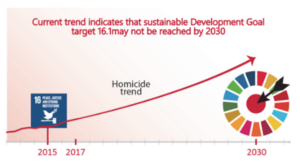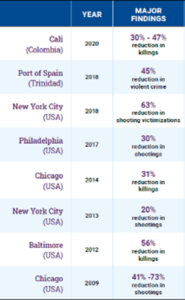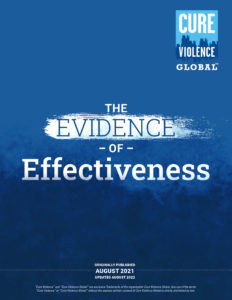
Violence is the third leading cause of death in the United States for people under 45 years old according to the CDC. Much of the violence is concentrated in low-income, communities of color, with African American people dying by violence at seven times the rate of White people. This trend holds globally. UN data indicates that more than 450,000 people are killed each year across the world, predominantly in impoverished areas with racial and ethnic minority populations.
To combat this global crisis, communities urgently need evidence-based approaches to preventing violence that have a track record of success. More than 15 years of research on the Cure Violence approach has provided the field of violence prevention growing evidence that community-based, public health approaches to violence are effective.
As a resource to the field and policymakers, Cure Violence Global (CVG) recently released an updated version of The Evidence of Effectiveness, a report detailing evaluations and studies on the Cure Violence approach. This updated version adds several new and recently discovered evaluations.

Table showing results from Cure Violence evaluations
The new report includes 22 analyses of the Cure Violence approach from sites around the world, each providing evidence of effectiveness. The studies cover Cure Violence sites across four continents and eight countries, including four countries in Latin America. For example, studies have found that sites in the US have been associated with significant reductions in shootings, including a 63% reduction in the South Bronx in New York City and a 56% reduction Central City in New Orleans. Programs in Latin America have had similar reductions in killings, including a 47% reduction in Charco Azul in Cali, Colombia.
This evidence helps to demonstrate to communities around the world that community-based, public health approaches can work to make communities safer in a sustainable manner. This approach has been cited by President Joe Biden in his 2022 State of the Union Address and is supported by mayors across the United States, as detailed in the report. The Cure Violence approach has been endorsed by UNICEF, USAID, the United States Department of Justice, the United States Conference of Mayors, and the National Governors’ Association. This evidence has helped to pave the way for the approach to violence to be more effective and more widespread.
As a public health approach, CVG has always prioritized research and evaluation. Data, monitoring, and evaluation are cornerstones of effective public health interventions. Interventions are continuously monitored so that adjustments can be made in real time to enhance effectiveness and adapt to changes. Cure Violence Global’s comprehensive database and data collection system has made research on this approach possible by capturing the types of data on program implementation that are required for high-quality evaluations.

A report on the evaluations on the Cure Violence approach
Cure Violence Global is proud to present this evidence in a comprehensive report, to support communities around the world in their efforts to make their communities safer. Whether at the local, state, federal, or international level, people advocating for community-based violence prevention can cite the evidence in this report to demonstrate that public health approaches can achieve large reductions in violence. The report can be shared with policymakers and funders, charts and tables from the report can be presented, statistics can be cited, and endorsements can be quoted by anyone working to bring resources to their community to implement violence prevention approaches.
Cure Violence Global hopes that the evidence presented in this report will help continue to advance the field of violence prevention.


